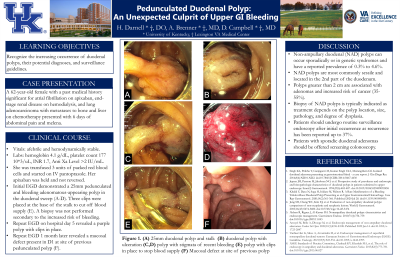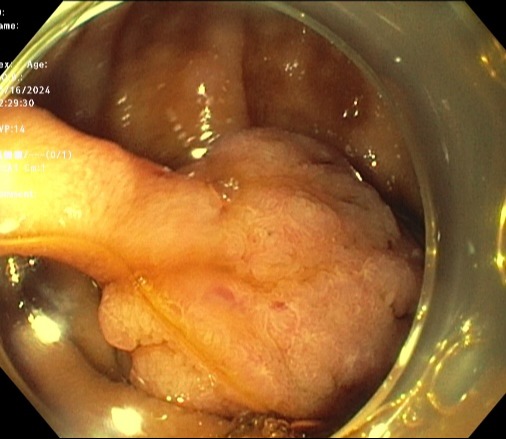Sunday Poster Session
Category: GI Bleeding
P0756 - Pedunculated Duodenal Polyp: An Unexpected Culprit of Upper Gastrointestinal Bleeding
Sunday, October 27, 2024
3:30 PM - 7:00 PM ET
Location: Exhibit Hall E

Has Audio

Hannah Darnell, DO
University of Kentucky
Lexington, KY
Presenting Author(s)
Hannah Darnell, DO, Aaron Brenner, MD, Donald Campbell, MD
University of Kentucky, Lexington, KY
Introduction: Sporadic, non-ampullary duodenal (NAD) polyps are rare, however, their prevalence has increased with the widespread use of upper endoscopy. We present a 62-year-old female who presented with melena found to be secondary to a large, bleeding, ulcerated, and pedunculated polyp in the duodenal sweep.
Case Description/Methods: A 62-year-old female with a past medical history significant for atrial fibrillation on apixaban, end-stage renal disease on hemodialysis, and lung adenocarcinoma with metastases to bone and liver on chemotherapy presented with 6 days of abdominal pain and melena. On arrival, she was hemodynamically stable. Labs were significant for hemoglobin 4.1 g/dL, platelet count 177 10*3/uL, and INR 1.7. She was transfused with 3 units of packed red blood cells, started on IV pantoprazole, and apixaban was held. She did not require apixaban reversal. The gastroenterology service was consulted, and esophagogastroduodenoscopy (EGD) demonstrated a 25mm pedunculated adenomatous-appearing polyp in the duodenal sweep. The head of the polyp was ulcerated with stigmata of recent bleeding. Hemostasis was achieved by placing 3 clips on the polyp stalk. Following clip placement, blanching of the entire head of the polyp was observed, suggesting successful interruption of its vascular supply. Biopsy was not performed secondary to the increased risk of bleeding. EGD was repeated on hospital day 5 and revealed a purple polyp with clips in place. Resection was not attempted due to poor positioning and risk of iatrogenic bleeding. Her hemoglobin remained stable, and she was discharged with a follow-up EGD in 1 month.
Discussion: Sporadic NAD polyps have a reported prevalence of only 0.3% to 4.6%. Most duodenal polyps are associated with hereditary syndromes, however, sporadic non-neoplastic and neoplastic polyps can occur. NAD polyps are most commonly sessile and located in the 2nd part of the duodenum. Polyps greater than 2cm are more associated with adenomas and increased risk of cancer. Although no biopsy was obtained from the polyp presented above, its appearance, size, and location make it quite rare and concerning for an adenoma. Biopsy of NAD polyps is typically indicated as treatment depends on the polyp location, size, and pathology. Patients should undergo routine surveillance endoscopy as recurrence has been reported up to 37%. Although rare, the incidence of duodenal polyps is increasing and physicians should be aware of the potential diagnoses, treatments, and surveillance guidelines.

Disclosures:
Hannah Darnell, DO, Aaron Brenner, MD, Donald Campbell, MD. P0756 - Pedunculated Duodenal Polyp: An Unexpected Culprit of Upper Gastrointestinal Bleeding, ACG 2024 Annual Scientific Meeting Abstracts. Philadelphia, PA: American College of Gastroenterology.
University of Kentucky, Lexington, KY
Introduction: Sporadic, non-ampullary duodenal (NAD) polyps are rare, however, their prevalence has increased with the widespread use of upper endoscopy. We present a 62-year-old female who presented with melena found to be secondary to a large, bleeding, ulcerated, and pedunculated polyp in the duodenal sweep.
Case Description/Methods: A 62-year-old female with a past medical history significant for atrial fibrillation on apixaban, end-stage renal disease on hemodialysis, and lung adenocarcinoma with metastases to bone and liver on chemotherapy presented with 6 days of abdominal pain and melena. On arrival, she was hemodynamically stable. Labs were significant for hemoglobin 4.1 g/dL, platelet count 177 10*3/uL, and INR 1.7. She was transfused with 3 units of packed red blood cells, started on IV pantoprazole, and apixaban was held. She did not require apixaban reversal. The gastroenterology service was consulted, and esophagogastroduodenoscopy (EGD) demonstrated a 25mm pedunculated adenomatous-appearing polyp in the duodenal sweep. The head of the polyp was ulcerated with stigmata of recent bleeding. Hemostasis was achieved by placing 3 clips on the polyp stalk. Following clip placement, blanching of the entire head of the polyp was observed, suggesting successful interruption of its vascular supply. Biopsy was not performed secondary to the increased risk of bleeding. EGD was repeated on hospital day 5 and revealed a purple polyp with clips in place. Resection was not attempted due to poor positioning and risk of iatrogenic bleeding. Her hemoglobin remained stable, and she was discharged with a follow-up EGD in 1 month.
Discussion: Sporadic NAD polyps have a reported prevalence of only 0.3% to 4.6%. Most duodenal polyps are associated with hereditary syndromes, however, sporadic non-neoplastic and neoplastic polyps can occur. NAD polyps are most commonly sessile and located in the 2nd part of the duodenum. Polyps greater than 2cm are more associated with adenomas and increased risk of cancer. Although no biopsy was obtained from the polyp presented above, its appearance, size, and location make it quite rare and concerning for an adenoma. Biopsy of NAD polyps is typically indicated as treatment depends on the polyp location, size, and pathology. Patients should undergo routine surveillance endoscopy as recurrence has been reported up to 37%. Although rare, the incidence of duodenal polyps is increasing and physicians should be aware of the potential diagnoses, treatments, and surveillance guidelines.

Figure: A rare 25mm pedunculated adenomatous-appearing polyp located in the duodenal sweep. Although not pictured from this angle, the head of the polyp was ulcerated with stigmata of recent bleeding. Hemostasis was achieved by placing 3 clips on the polyp stalk.
Disclosures:
Hannah Darnell indicated no relevant financial relationships.
Aaron Brenner indicated no relevant financial relationships.
Donald Campbell indicated no relevant financial relationships.
Hannah Darnell, DO, Aaron Brenner, MD, Donald Campbell, MD. P0756 - Pedunculated Duodenal Polyp: An Unexpected Culprit of Upper Gastrointestinal Bleeding, ACG 2024 Annual Scientific Meeting Abstracts. Philadelphia, PA: American College of Gastroenterology.
